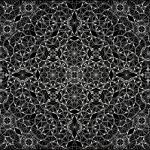Lawrie Shabibi is pleased to present All Borrow Their Light, the first solo exhibition of Berlin-based Timo Nasseri at the gallery. Offering a comprehensive glimpse into Nasseri’s oeuvre, the exhibition comprises a carefully curated selection of paintings and sculptures from various stages of the artist’s practice that contemplate concepts of mathematical and geometric thought models.
The exhibition’s focus is on a new large-scale painting entitled Atlas (2023) which extends to 4 metres in length and develops his earlier series entitled I Am a Sky Where Spirits Live (2022-2023). In these paintings Nasseri applies forms inspired by the ‘Razzle Dazzle’ camouflage used by the British and US Navy in World War I and II as a tactic to avoid detection. The vibrantly coloured recurring forms on the canvas are reminiscent of geometric patterns in a gigantic kaleidoscope and incorporate elements of camouflage from the animal kingdom, fractals, indigenous traditions, and Cubist paintings based on human perceptual mechanisms.
Nasseri’s fascination with geometry traces itself back to his interest in Islamic architecture and his study of Muqarnas ornamentation – a honeycomb geometric design in Islamic architecture that originated in the 10th or 11th century, typically built into the underside of domes and arches and decorative in nature. By breaking down its core elements and analysing its rhythm and structure, Nasseri explores the Muqarnas’s ideological, mathematical and geometric relationship to logic and the creation of the universe. In All Borrow Their Light, Nasseri presents two works from an ongoing series examining the Muqarnas: his Epistrophy sculptures (2007- present) and his One and One drawings (2008 to present).
Epistrophy #8 (2017) is a large-scale polished steel geometric sculpture which derives its shape from the internal structure of a typical Muqarnas. By embedding it in the wall, the viewer sees the shape head-on so that the polished mirrored surface appears boundless and reflects the surroundings in multiple ways. This fragmentation of the reflection of the space becomes part of the artwork recreating the geometric structure of the Muqarnas, which at the time was portrayed as an entire universe of possible forms.
One and One #49 (2023) is part of Nasseri’s ongoing series of detailed geometric drawings made with white ink on black paper. Using only a ruler and compass, these drawings feature a repeating pattern that expands from the centre using triangles arranged in a particular rhythm to create repeating geometric patterns. Appearing to extend outwards infinitely, these drawings are like blueprints of his stainless-steel sculptures, delving into the mathematical beauty of Islamic architecture, geometry, and mathematics.
Storytelling and narrative play a role in the exhibition, blending the fantastical with the real and possible, as revealed in the series entitled Teardrop Vessels and series entitled Unknown Letters.
Teardrop Vessels is a series of clay sculptures made by the artist in response to the Covid-19 pandemic. The exhibition features 80 of these clay works in varying forms, sizes and shades of charcoal grey: arranged in clusters, their shapes and vast quantities suggest the ritualist daily meditative practice these “tear-catchers” embody. Some of the shapes have a primordial quality about them, whilst others evoke the functional and minimal design style of the German modernist Bauhaus school, although their functionality is invented.
In his Unknown Letters series Nasseri created four sculptures (one of which is presented) each carved out of walnut in the shape of an imagined Arabic letter. These sculptures were inspired by the life of the calligrapher Ibn Muqla (885-940, Baghdad), who attempted to add four letters to the Arabic alphabet in 935 – none of which were added. Nasseri began in-depth research of the Arabic script and alphabet, paying particular attention to its forms and aesthetics. ‘While searching for the letters, it occurred to me that Ibn Muqla might have seen missing letters in the stars.’ He created his own letters based on the shapes of constellations in the stars that existed during the time of Ibn Muqla – none of which attach to any specific sound.
“Nasseri’s practice involves alternating between ancient techniques derived from Islamic and Persian art and architecture, exploring modern and contemporary Euro-American art historical and philosophical concepts. By doing so, he creates a visual representation of the intersection of abstraction and symbolism through complex codes and patterns of ‘consciousness’ that he embeds into his art” (“Timo Nasseri: The Pursuit of Truth” original essay by Sara Raza, 2023).
Press release from Lawrie Shabibi.



